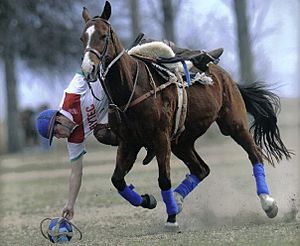Pato facts for kids

Pato is an exciting game played on horseback, a bit like a mix of polo and basketball. It's the official national sport of Argentina.
The word Pato means "duck" in Spanish. Long ago, instead of a ball, players used a live duck inside a basket! People have been playing Pato since at least 1610. In those early days, the game often stretched between different ranches. The first team to bring the duck back to their own ranch house won the game.
Pato was actually banned many times in the past. This was because the game could be very rough. Not only was it hard on the duck, but many gauchos (Argentine cowboys) were hurt. Sometimes, arguments during the game even led to serious fights. In 1796, a Catholic priest even said that Pato players who died in such ways should not have a Christian burial. Laws against playing Pato were common throughout the 1800s.
In the 1930s, a ranch owner named Alberto del Castillo Posse helped bring Pato back. He created new rules for the game, making it safer and more like modern polo. Then, in 1953, President Juan Perón officially declared Pato the national game of Argentina.
How Pato is Played
In today's Pato game, two teams, each with four players, ride on horses. Their goal is to grab a special ball that has six handles. They score points by throwing this ball through a large, vertical ring. These rings are about 100 cm (3.3 ft) wide and are placed on poles that stand 240 cm (7.9 ft) high. A net below the ring catches the ball after a goal is scored.
The team that scores the most goals by the end of the game wins. A game usually has six periods, and each period lasts for 8 minutes.
The Field and Ball
The playing field for Pato is quite large. It's usually between 180 to 220 meters (196.9 to 240.6 yards) long and 80 to 90 meters (87 to 98 yards) wide. The ball itself is made of leather and has an air-filled rubber inside. It measures about 40 cm (15.7 in) from handle to handle and weighs between 1050 to 1250 grams (2.3 to 2.8 lbs).
Player Actions
When a player has control of the pato (meaning they are holding the ball by a handle), they must ride with their right arm stretched out. This is important because it gives rival players a chance to try and grab the ball from them. If a player doesn't hold their arm out while riding with the ball, it's against the rules. This is called a negada (refusal).
When two players are trying to pull the ball from each other, this is called a cinchada. During a cinchada, both players must stand up in their stirrups and not sit on their saddle. The hand that isn't pulling the ball must hold the reins of their horse. The cinchada is often the most exciting part of the game!
Pato is quite similar to a game called horseball, which is played in countries like France and Portugal.
Images for kids
See also
 In Spanish: Pato (deporte) para niños
In Spanish: Pato (deporte) para niños





